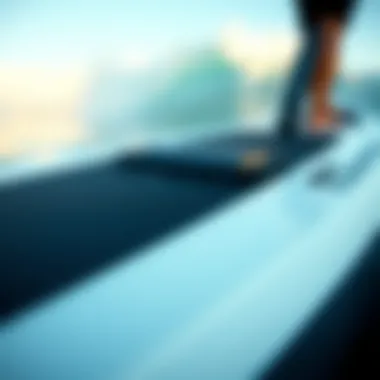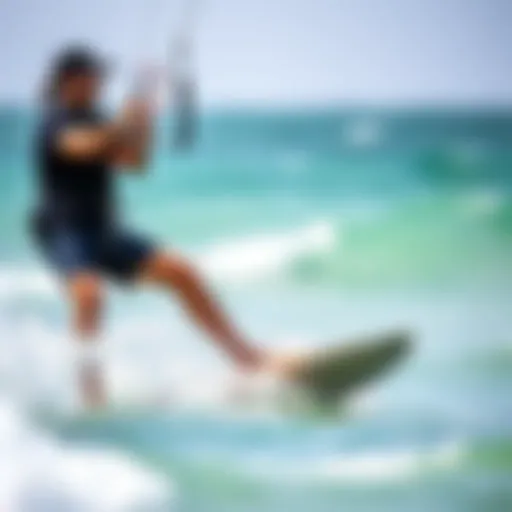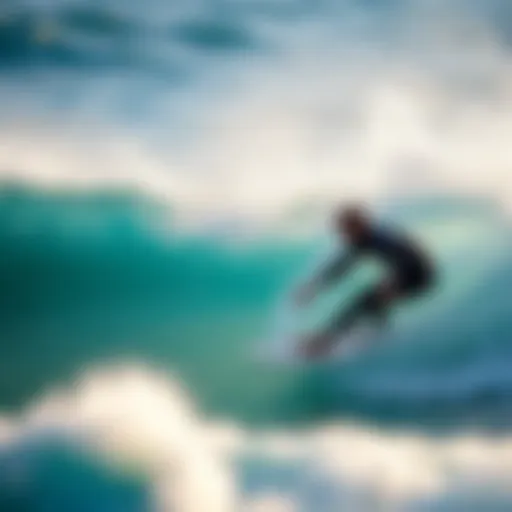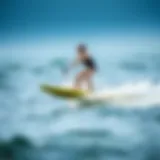Comprehensive Guide to Wing Paddle Boards


Intro
In the world of water sports, wing paddle boarding is carving a niche that brings together elements of kiteboarding and traditional paddle sports. This hybrid has captured the attention of enthusiasts and newcomers alike, who find the combination of thrill and skill appealing. Packed with innovation and designed for improved performance, wing paddle boards offer many benefits that traditional boards cannot match. Ample opportunity awaits on the water, but knowing the ins and outs of this activity is essential for a fulfilling experience.
This guide will unfold meticulously, shedding light on the intricacies associated with wing paddle boarding. We’ll go deep into the materials that comprise these boards, examine effective paddling techniques, and explore how this burgeoning sport has found its way into the hearts of many. Each section aims to arm both novice paddlers and seasoned riders with insights that could enhance their skills and elevate their enjoyment.
Techniques for Kiteboarding Enthusiasts
Mastering wing paddle boarding is not just about balancing on the board or navigating the wind. Techniques vary widely, and different strategies can make a world of difference, particularly for kiteboarding enthusiasts ready to step into this new terrain.
Beginner Techniques
For those just starting out, it’s essential to build confidence on the water. Here are some key beginner techniques:
- Body Positioning: Stand with your feet shoulder-width apart and keep your knees slightly bent. This lower center of gravity helps with stability.
- Wing Handling: Familiarize yourself with the wing’s pull. Start by holding it without getting on the board. This will teach you how to control it effectively.
- Starting Off: Place your board in the water, and when ready, gently pull the wing to catch the wind while standing up on the board. Avoid rushing this step; stability comes with practice.
- Balance Control: Looking straight ahead can help maintain balance. If you feel wobbly, bend your knees more and lean slightly forward.
Advanced Maneuvers
Once comfortable cruising, you may want to up your game. For the more experienced paddlers, these advanced techniques can broaden your repertoire:
- Jibe Turns: This requires carving through the water and switching your feet during the turn. It allows you to change direction effectively without losing speed.
- Jumping: Using the wind’s lift, practice catching air momentarily. Timing and body position are crucial – spring upward as you pull on the wing to maximize lift.
- Tacking: This involves zigzagging upwind while maintaining momentum. Pay attention to the wing’s angle in relation to the wind flow for optimal performance.
Consider setting up a practice routine that incorporates these techniques, allowing time for fundamental practice before moving onto more complex maneuvers.
“Wing paddle boarding is more than just a sport; it's a dance with nature, where each swing of the wing could either make you soar or dip into the depths.”
Mastering these elements not only enhances your paddle experience but also integrates skill from other water sports, such as kiteboarding, seamlessly into one enjoyable activity. The beauty lies in progressing from one skill level to the next, discovering new challenges as you ride the waves.
The adventure doesn’t stop with just knowing how to paddle; understanding your equipment is equally critical.
Equipment Reviews
Selecting the right gear can set the tone for your experience on the water.
Kite Reviews
When choosing a kite, consider factors such as size, material quality, and handling ease. Brands like North Kiteboarding and Duotone offer kites tailored to different wind conditions.
Board Reviews
Paddle boards come in various shapes and sizes, each designed for specific scenarios. For instance, the Naish Hover and Slingshot Wizard are popular models with differences in buoyancy and stability.
Ultimately, investing time in research will yield a more enjoyable experience, whether you are a novice or a seasoned paddler.
Prolusion to Wing Paddle Boarding
Wing paddle boarding is an innovative fusion of traditional paddleboarding and the exhilarating dynamics of wind-powered sports. This approach allows paddlers to harness the winds, maneuvering over water with a unique combination of leisure and sport. Understanding this emerging discipline is crucial not only for those new to water activities but also for seasoned athletes looking to expand their skills.
Definition and Overview
Wing paddle boarding can be defined as a water sport where an individual stands on a large, buoyant board and uses a handheld wing sail to propel themselves across the surface of the water. The primary allure of this sport lies in its simplicity and accessibility, offering a medium for enjoyment as well as a rigorous workout. Whether gliding on calm lakes or riding the coastal waves, wing paddleboarding invites enthusiasts to explore the natural world while engaging their muscles and honing their balance.
Some key elements that define the sport include:
- The Board: Typically wider and longer than traditional paddleboards, designed for stability.
- The Wing Sail: A portable, inflatable sail that is controlled manually, allowing for direct wind propulsion.
- The Technique: Involves paddling, steering, and utilizing wind effectively to navigate diverse water conditions.
This sport has rapidly gained traction in recent years, moving away from niche to mainstream appeal, particularly among kiteboarders and enthusiasts seeking fresh challenges on the water.
History and Evolution
The roots of wing paddle boarding trace back to the early 20th century when toy sailboats and larger sailing vessels began experimenting with wind-catching surfaces. However, it wasn't until recent decades that innovation accelerated in wing design and paddleboard construction. In its early days, wing paddleboarding was largely unregulated and sporadically embraced at coastal locales.
As companies recognized its potential, investment poured in to refine wing technology, leading to lightweight, durable materials with advanced aerodynamic characteristics. This ultimately laid the groundwork for a sport defined by versatility and thrill. Key moments in history shaped its popularity:
- The introduction of inflatable wings in the 2000s made this sport accessible, allowing paddlers to carry equipment easily.
- Development of hybrid boards combined features of both stable paddleboards and maneuverable wings, making it easier for new participants to join.
- Growth of communities and organized events across the globe fostered a vibrant culture around wing paddleboarding, revolutionizing the way enthusiasts interact with water sports.
Understanding the historical evolution of wing paddle boarding, paired with its dynamic definition, prepares readers to appreciate the intricacies of this exciting activity. By grasping the foundation of it, both novices and experienced paddlers can make informed decisions about techniques, gear, and locations for their adventures.
Understanding Wing Paddle Boards
Wing paddle boards are at the cutting edge of water sports, blending elements from traditional paddle boarding with the latest innovations in design and technology. Understanding wing paddle boards not only enhances one's technical skills but also deepens appreciation for their capabilities and benefits. This section delves into the essence of these boards, separating the wheat from the chaff, so paddlers can make informed choices.
Construction Materials
The materials used in wing paddle boards play a critical role in their performance and longevity. Knowing what goes into the making of these boards gives enthusiasts a leg up in selecting the right gear.
Common Materials
Most wing paddle boards are crafted from a variety of materials including EPS foam, fiberglass, and often a layer of carbon fiber for strength. EPS foam is lightweight and provides buoyancy, making it a great choice for paddlers seeking ease of maneuverability.
- Key Characteristic: Lightweight nature of EPS foam lowers the effort needed for paddling.
- Unique Feature: Glass-reinforced plastic offers durability against impacts and chipping.
However, relying solely on fiberglass can be a double-edged sword. While it offers decent strength, it might not withstand extreme conditions as well as more advanced materials.
Advantages of Material Choices


Choosing the right materials comes with its own set of advantages. The combination of materials provides a balance of lightness and durability.
- Key Characteristic: The hybrid construction of boards results in flexibility and responsiveness while paddling.
- Unique Feature: Increased resistance to dings and scratches means boards maintain their aesthetic and functionality longer.
This choice of materials results in boards being lightweight yet tough, catering to both beginners and experienced paddlers alike. Lightweight boards make it easier to catch waves, while durability ensures they can handle the wear and tear.
Design Features
The design aspect of wing paddle boards is equally significant, as this affects not just aesthetics but also performance on the water.
Shape and Size
The shape and size of wing paddle boards vary widely, influencing their stability and speed. Most boards range from 10 to 12 feet in length, with wider designs enhancing stability.
- Key Characteristic: A longer board tends to glide more smoothly, while a shorter one may offer better maneuverability.
- Unique Feature: The use of a pointed nose design helps in slicing through water efficiently.
This balance between width and length enables paddlers to adapt to different water conditions while providing the needed buoyancy and glide needed for different skill levels. It's a crucial consideration for those looking to master the sport.
Stability and Floatation
Stability and flotation are often the unsung heroes of any wing paddle board's design. Wider boards provide a more stable platform, which can be particularly beneficial forbeginning paddlers.
- Key Characteristic: Enhanced floatation properties mean increased buoyancy; keeping the paddler above water, reducing fatigue.
- Unique Feature: A board with minimal rocker provides a flatter surface, often leading to better speed and tracking in flat waters.
Selecting a board with appropriate stability features can greatly influence a paddler's confidence and experience on the water. It's essential for both recreational paddlers and those delving into more advanced maneuvers.
Benefits of Wing Paddle Boarding
The allure of wing paddle boarding lies not just in its adrenaline-pumping action but also in its significant health and wellness advantages. As enthusiasts flock to the water, they often find that engaging with this sport extends far beyond merely gliding over the waves. It intermingles physical fitness with mental rejuvenation, resulting in a holistic experience that appeals to both body and mind. Let's dive into the depths of its benefits, both physical and mental, and understand why they matter to paddlers everywhere.
Physical Health Benefits
Cardiovascular Fitness
One key area where wing paddle boarding shines is its ability to enhance cardiovascular fitness. As you paddle against the currents or ride the winds, your heart rate increases, supplying vital oxygen to your muscles and organs. This physical activity helps to build stamina and endurance, acting as an effective workout that can rival running or cycling. The rhythmic nature of paddling establishes an almost meditative quality to the exertion.
A standout characteristic of this fitness boost is the incorporation of varying intensities. Riders often find themselves switching gears—racing against winds or patiently coasting. This variation allows for both strength building and cardiovascular conditioning. It’s a compelling choice for those who prefer exercising outdoors, combining the joys of nature with beneficial movement. However, it is essential to note that beginners should start slowly to avoid overwhelming themselves, especially if they're new to aerobic activities.
Muscle Engagement
The sport also promotes excellent muscle engagement across the body, particularly in the core, arms, and legs. When performing the paddling motion, various muscle groups are activated, promoting strength and flexibility. The action demands balance and coordination, which not only engages muscles but also enhances overall bodily awareness.
An impressive trait of this muscle engagement is its functional fitness nature, which prepares practitioners better for other physical activities. For those involved in water sports or athletic pursuits, these enhanced muscles can reduce the risk of injuries. It’s fascinating to watch how consistent wing paddle boarding leads to toned muscles and improved athletic performance, contributing significantly to many paddlers' overall fitness journeys. Yet, engaging too much too soon can cause strain, so a gradual buildup of intensity helps prevent overexertion.
Mental Health Benefits
Stress Relief
Paddling on open waters contributes significantly to stress relief. Being surrounded by nature while engaging in physical activity promotes relaxation and can lower anxiety levels. For many, the sound of waves and the fresh scent of the sea create a soothing environment that clears clutter from the mind. Wing paddle boarding often serves as a perfect escape from the daily grind, offering a breath of fresh air—quite literally.
One of its standout characteristics is the flow state that can develop during paddling. The repetitive motion, paired with focused breathing, can lead to a meditative experience. As a result, participants often report feelings of elation and clarity post-session. Nevertheless, it’s important to find the right environment; a busy beach might hinder that peaceful vibe one seeks.
Mindfulness and Focus
Last but not least, wing paddle boarding fosters mindfulness and concentration. The need for awareness of one’s surroundings and body movements encourages paddlers to stay present. Unlike some high-pressure sports, wing paddle boarding allows space for reflection and self-awareness, enhancing focus on the activity at hand.
A beautiful aspect of this mindfulness is how it spills over into other facets of life. Practitioners often discover that they can carry this heightened focus into daily routines, benefiting productivity and emotional well-being. However, those new to the sport might initially struggle with concentration if conditions change rapidly, highlighting the importance of adaptability in their practice.
In summary, wing paddle boarding offers myriad physical and mental health benefits. From improving cardiovascular fitness and muscle engagement to fostering stress relief and mindfulness, this activity marries the thrill of sports with essential well-being elements. For anyone looking to enhance their fitness while enjoying the great outdoors, it promises an enriching journey.
Comparative Analysis
In the realm of water sports, especially in paddle boarding, understanding the nuances between varying types of boards can significantly enhance your experience and performance. This section aims to dissect the differences and similarities between wing paddle boards and traditional paddle boards. By diving into this comparative analysis, enthusiasts can glean insights into the practical dynamics of each type, enabling informed decisions when selecting gear or refining techniques.
Wing Paddle Board vs. Traditional Paddle Board
Oh, the great debate! On one side, we have the traditional paddle boards that have been around for ages, providing a steadiness and simplicity that many adore. On the flip side, wing paddle boards have come to light, bringing some thrilling differences to the forefront.
Wing paddle boards are equipped with a wing and harness system, allowing paddlers to use the wind for propulsion. This means you can glide across the water's surface with less effort, particularly in breezy conditions. Conversely, traditional paddle boards require a steadfast paddle for thrust, relying heavily on the paddler's core and arm strength.
Below are some key features to consider when comparing the two:
- Propulsion Method:
- Technique Required:
- Speed and Efficiency:
- Wing Paddle Boards: Uses wind and wings for movement.
- Traditional Paddle Boards: Manual paddling through the water.
- Wing Paddle Boards: Demands skill in managing wind direction and wing angle.
- Traditional Paddle Boards: Focuses on paddle strokes and balance.
- Wing Paddle Boards: Generally faster due to wind assistance.
- Traditional Paddle Boards: Slower, relying on human power alone.
Moreover, wing boards are often shorter and wider than their traditional counterparts, which can influence maneuverability and stability. While a wing board can offer a lively ride in windy conditions, it may feel less stable in calm waters compared to a traditional board, which is designed for steady gliding.
Advantages and Disadvantages
Every coin has two sides, so let’s break down what’s advantageous and what’s not in both types of paddle boards.


Wing Paddle Board Pros:
- Reduced Physical Effort: With wind assistance, you'll find it easier to cover more distance with less fatigue.
- Speed: Experience exhilarating speeds, especially if you’ve got favorable wind conditions, and enjoy the thrill of powered glide.
- Unique Techniques: Learn new skills that can be fun and rewarding, increasing your versatility as a paddler.
Wing Paddle Board Cons:
- Dependence on Wind: Not ideal on calm days; if there's no wind, you may be stuck paddling in circles.
- Learning Curve: It can take time to master the coordination of the wing and balance, making it less accessible for beginners.
- Cost: Generally, wing paddle boards can be pricier due to specialized gear and materials.
Traditional Paddle Board Pros:
- Reliability: Excellent for all conditions, making it usable regardless of wind.
- Stability: Provides consistent balance for beginners to build confidence on the water.
- Diverse Options: Available in various styles suited for different preferences from leisure paddling to surfing.
Traditional Paddle Board Cons:
- Physical Demand: Requires more strength, particularly for endurance paddling.
- Speed Limitations: Generally slower without the advantage of wind propulsion.
By examining these aspects, paddlers can determine their personal needs and preferences when selecting a board. Each has its valid place along the spectrum of water sport activities, so aligning one’s style with the right equipment is key. Regardless if you lean toward the traditional or embrace the vibrant excitement of wings, each experience on the water can teach something valuable.
"In every wave, there lies a lesson; not just about the water, but about ourselves."
As we explore the future of wing paddle boarding, understanding these comparisons will serve as a compass guiding practitioners toward fulfilling experiences on the water.
Technique and Skill Development
The realm of wing paddle boarding is not merely about the thrill of gliding across water or the rush of harnessing wind; it's about cultivating mastery over skills and techniques that enhance your experience and safety on the water. As the saying goes, "practice makes perfect," and this is particularly true for aspiring wing paddlers. Developing a solid foundation in both basic and advanced techniques allows enthusiasts to navigate various conditions, increasing both enjoyment and safety.
Basic Techniques
Starting and Stopping
Understanding how to start and stop smoothly on a wing paddle board is crucial for anyone diving into this sport. The starting process requires positioning yourself correctly, with your feet firmly planted and body weight balanced. You need to catch the wind with the wing effectively, as that’s the fuel for propelling yourself forward. Stopping, on the other hand, involves coordinating your paddle and wing in a way that you can gradually reduce speed before coming to a complete standstill.
The key characteristic here is the fluidity of movement. Rushing or panicking during these steps can lead to missteps and falls, often embarrassing those who are just getting started. However, mastering this technique allows for seamless transitions – an experience both new and seasoned paddlers value greatly. One unique advantage of refining starting and stopping skills is the boost in confidence it affords. As paddlers become adept, they can tackle more challenging conditions, taking their skills to new heights.
Turning and Maneuvering
Turning and maneuvering on a wing paddle board is where the true art of paddle boarding begins. It requires practice to develop the ability to swiftly change direction while maintaining balance. Utilizing your paddle while adjusting the positioning of the wing is essential. When executed correctly, this technique can make your ride feel almost effortless, as if you’re dancing with the water.
A notable characteristic of turning is its role in extending the range of where you can go. Mastering quick turns enables paddlers to navigate tighter areas, avoid obstacles, and even enhance their tricks as they become more comfortable with their board’s responsiveness. While it may take time to perfect your abilities, the reward of confidently maneuvering on water is undeniable. That said, if not practiced properly, turning can lead to loss of balance and spills, making it important to approach this technique thoughtfully.
Advanced Techniques
Jumping and Tricks
As paddlers develop their skills, the desire to incorporate jumping and tricks becomes prevalent. This aspect contributes to the excitement of wing paddle boarding and offers a sense of creative expression on the water. The key here is to learn the mechanics of lift and landing, combining speed with strategic movements. Jumping too soon or inconsistency in technique can result in falling and potential injury, so it’s crucial to build from a solid foundation of basic skills first.
Jumping is a thrilling characteristic of advanced wing boarding. When done right, it can elevate your overall experience, making it exhilarating and dynamic. One advantage is that successfully executing tricks can boost your confidence, drawing admiration from fellow paddlers. The downside is that it requires a lot of dedication and practice. Many stick with the basics for longer before attempting to leap, which can be seen as a barrier to entry for some.
Wave Riding Skills
Wave riding introduces an entirely new dimension to wing paddle boarding, bridging the gap between paddle sports and surfing. This technique emphasizes understanding the ocean's dynamics, allowing paddlers to catch and ride waves effectively. Strategy plays a large role here; positioning yourself correctly to ride a wave means knowing when and where to paddle, and how to adjust your balance to maintain speed and stability.
The unique feature of wave riding lies in the thrill it offers; riding a wave feels like flying, pushing many paddlers to seek out new adventures. A major benefit is that wave riding significantly improves a paddler's overall skills, teaching them to react swiftly to changing conditions. However, it requires a good understanding of the environment and a degree of risk, as it can lead to wipeouts if not approached with respect and care.
In summary, mastering these techniques, whether basic or advanced, forms the backbone of wing paddle boarding. It's not just about towing a board along; it’s about building confidence, facilitating movement, and refining your skills to enhance both safety and experience.
Safety Considerations
Engaging in wing paddle boarding is undeniably exhilarating, but it comes with a notable set of risks that necessitate proper safety measures. The multiple variables involved, such as the water environment, equipment handling, and physical capabilities, dictate the importance of a thorough understanding of safety standards. By recognizing potential dangers and adhering to best practices, paddlers can ensure their adventures remain enjoyable and safe for everyone involved.
Essential Safety Gear
Life Jackets
When it comes to safety gear, life jackets hold a critical position. These buoyancy aids aren't just garments; they are lifelines in emergencies. The key characteristic of life jackets is their ability to keep individuals afloat, especially in tumultuous waters. A popular choice for both novice and experienced paddlers, life jackets help prevent drowning, which is paramount considering varying water conditions.
What sets a good life jacket apart is its comfort and fit. Many modern designs come with adjustable straps and lighter materials, ensuring that freedom of movement is not compromised. Some models even feature additional pockets for storing small essentials, which is a unique benefit during long paddles. However, it’s crucial to remember that while a life jacket can save a life, it must be worn correctly to be effective.
Helmets and Other Protective Equipment
Equally important are helmets and other protective equipment. When paddling, especially in turbulent waters or among rocky areas, head protection should not be taken lightly. Helmets are designed to safeguard against unexpected falls or collisions, which are prevalent hazards in wing paddle boarding. The key characteristic of a good helmet is its lightweight and durable construction, allowing for ease of wear without hindering movement.
Furthermore, helmets can come equipped with added features like visors for sun protection or ventilation systems for breathability. Each of these features can enhance the paddler's experience and safety. But like any equipment, there are disadvantages—helmets can feel bulky, and some paddlers may feel restricted while wearing one. It’s a balance between safety and comfort that each paddler must weigh.
Environment Awareness
Understanding Water Conditions
Being aware of water conditions is another cornerstone of safety in wing paddle boarding. Paddlers must assess conditions like wave height, current strength, and wind speed before heading out. Understanding these factors is crucial for ensuring both personal safety and the safety of others on the water. For instance, a quaint calm lake can shift dramatically with sudden winds, making it a challenging environment for unprepared individuals.
Knowledge of water conditions not only helps in planning the right time to paddle but also informs decision-making on when to head back to shore. The ability to read water patterns can separate an enjoyable day from a potentially perilous situation, making it an essential skill for all paddlers, from novices to seasoned pros.
Weather Considerations
Weather conditions often change without warning—this makes weather considerations pivotal for paddlers. Low visibility, sudden storms, or strong winds can alter the safety landscape dramatically. Knowledge of weather patterns can help in choosing the right times and locations for wing paddle boarding, fundamentally protecting lives.


Appropriate clothing and gear should also be dictated by the weather. Clear skies and warm temperatures permit lighter attire, while changes towards cooler weather warrant layers and performance wear that insulate against wind chill. The ability to anticipate these weather shifts will allow paddlers to adjust quickly and strategically, thus ensuring a safe and enjoyable experience.
Maintenance and Care
Maintaining your wing paddle board is as crucial as selecting the right one to begin with. Not only does proper care ensure the longevity of your board, but it also affects your overall performance on the water. Neglecting routine checks can lead to damage, which could cost a pretty penny to fix or even render the board unusable. With a little bit of forethought and diligence, you can keep your investment in top shape and enjoy your time out on the waves for many seasons to come.
Routine Checks
Performing routine checks involves several straightforward tasks that every paddler should familiarize themselves with. These checks are critical in identifying potential problems before they escalate.
- Inspect for Damage: Look for any dings, scratches, or punctures. These imperfections may seem minor at first but can lead to larger issues such as water seepage. A small crack can swiftly turn into a significant leak if not attended to.
- Check Fins and Straps: Ensure fins are secure and undamaged. A loose or broken fin can completely alter your tracking, causing unintentional veering while paddling. The straps that hold your wing in place should also be inspected to ensure they are not frayed or compromised.
- Look for Delamination: This often happens with boards made from fiberglass. If you notice any bubbling or the outer layer lifting away from the foam core, it may be a sign of delamination – a serious issue that needs to be addressed immediately.
- Clean Regularly: Rinse your board with fresh water after every use to remove salt, sand, or debris that might affect its integrity. Using a gentle soap once in a while can help keep the surface clean and slick.
- Check Inflation Levels: If you have an inflatable wing paddle board, make sure it’s properly inflated to the recommended psi levels. An under-inflated board can lead to poor performance and is prone to damage.
Regular attention to these areas will help you identify and tackle issues before they grow into costly repairs.
Long-term Storage
When the wing paddle boarding season winds down, or if you're just taking a break, how you store your board can make all the difference. Here are some tips for effective long-term storage:
- Clean Thoroughly: As mentioned, rinsing your board is essential. Make sure to remove all grime and moisture before storage. A clean board is less likely to develop mold or mildew, which can be damaging over time.
- Dry Completely: Before putting your board away, let it dry entirely. Water trapped anywhere can promote decay and weakening of materials, especially if it’s cardboard or foam-based.
- Store Indoors: If possible, keep your paddle board indoors in a climate-controlled environment. Extreme temperatures and conditions can detrimental to the board’s structure. If indoor storage isn’t feasible, keep it covered and out of direct sunlight.
- Positioning Matters: Store the board standing upright or resting on its side, rather than laying flat. This helps avoid any unnecessary pressure on its structure, which might lead to distortion over time.
- Use a Bag or Cover: Invest in a board bag or cover, as it provides an extra layer of protection against dust, sunlight, and other elements that could degrade its condition.
By adhering to these maintenance and storage practices, you can ensure that your wing paddle board remains in prime condition for your next adventure, allowing you to focus on the thrill of the ride instead of worrying about equipment failures.
Proper maintenance is the key to maximizing performance and enjoyment in wing paddle boarding. Take the time to check and care for your board, and it will repay you on the water.
For detailed maintenance guidelines, consider visiting resources like Reddit or Wikipedia that cater to water sports enthusiasts.
Popular Locations for Wing Paddle Boarding
Choosing the right location for wing paddle boarding can make or break your experience. The beauty of this sport is that it can be enjoyed in diverse environments, but not all spots offer the same thrill or safety. Understanding where to paddle can enhance not just your skills, but also your enjoyment. It plays a vital role in connecting enthusiasts like kiteboarders and instructors with nature, creating a shared community experience. This section focuses on two main types of venues: global hotspots and regional favorites, so let’s explore what makes these locations worth your time.
Global Hotspots
When it comes to prime locations for wing paddle boarding, certain beaches and lakes stand out. These places are not just popular due to their natural beauty, but also because they provide favorable conditions for both novices and seasoned paddlers.
Beaches
Beaches often take the cake when it comes to wing paddle boarding venues. The combination of vast open waters and gentle breezes makes beaches an inviting choice. One of the biggest advantages of beach locations is the accessibility they offer; with many beaches being near urban centers, it's easy for new paddlers to jump right into the action.
What’s unique about beaches is their ability to accommodate a variety of skill levels. Whether you’re just learning the ropes or showing off some tricks, there’s usually a stretch of water suited for you. Additionally, beaches often have amenities like rentals and instruction available, making your trip hassle-free. However, there are drawbacks; crowded conditions can sometimes mean less space to maneuver, which might hinder practice for more advanced techniques.
Lakes and Reservoirs
On the flip side, lakes and reservoirs offer a distinctly different experience. These bodies of water tend to be calmer and more reflective, which can create a tranquil atmosphere. The stillness of the water can be beneficial for those just starting to get their footing in wing paddle boarding.
A key characteristic of lakes and reservoirs is their ability to provide protection from ocean swells and winds, allowing more cultivation focus. While they may lack the dynamic waves of a beach, reservoirs often have scenic views, surrounded by nature, enhancing the paddle boarding experience. That said, they may not have the same community vibe that you find on popular beaches, and potential access may be limited in some areas.
Regional Favorites
Apart from global hotspots, many paddlers develop a fondness for local spots that may not have the fame of more popular areas but offer unique delights. Finding hidden gems can lead to memorable moments, often with fewer crowds and a more personal connection to the environment. Local clubs and groups often know where those spots are, so consider tapping into those resources for recommendations and shared experiences.
This deeper dive into the popular locations for wing paddle boarding emphasizes not just the thrill of the sport, but the community and connection to nature that lies at its core. Wherever you decide to paddle, ensuring the location suits your skill and interest will undoubtedly enhance your adventure.
Community and Events
The realm of wing paddle boarding is more than just a solitary pursuit; it's a vibrant community that thrives on shared experiences and collective growth. Engaging with others in this sport can amplify your learning and enjoyment while fostering meaningful connections and friendships. This section will delve into the pivotal role that community and events play in enhancing the wing paddle boarding experience, whether you're a novice finding your ground or a seasoned pro looking to refine your skills.
Clubs and Groups
Organizations dedicated to wing paddle boarding provide invaluable resources. These clubs often act as a haven, bringing together enthusiasts from all skill levels. Joining a local wing paddle board club often comes with myriad benefits:
- Skill Development: Clubs frequently hold regular meet-ups or training sessions. This not only allows for on-water practice but also gives members the opportunity to share tips and techniques. Learning from others can drastically trim the learning curve for newcomers.
- Resource Sharing: Many clubs have access to high-quality equipment and resources. Members might have the chance to try different boards or wings without the financial strain of purchasing their own.
- Social Connections: A key aspect of these clubs is the camaraderie they instill. Sharing adventures and experiences fosters a sense of belonging. You will find friends to paddle alongside, swap stories with, and even plan trips together.
- Safety in Numbers: Paddling in a group can be safer and more enjoyable. Members can keep an eye on one another, which is particularly important for those forging into unfamiliar waters.
Example: Groups like the “Wing Paddle Club of California” facilitate organized meet-ups, including coastal flotillas where paddle boarders can safely explore and navigate the beautiful Pacific waters together.
Competitions and Gatherings
Engaging in competitions and gatherings takes wing paddle boarding to another level. These events are not merely about winning; they encapsulate the spirit of the sport while promoting excellence and pushing boundaries. Key benefits of participating in these gatherings include:
- Skill Showcase: Competitions allow participants to demonstrate their abilities under pressure. This experience can boost confidence and inspire others in their paddle journey.
- Expert Coaching: Many events feature workshops led by seasoned athletes. Attending these sessions can enhance your technique and broaden your skill set. Exposure to various styles from accomplished paddlers might introduce you to new ideas.
- Networking Opportunities: These events gather not just paddlers, but also industry professionals, sponsors, and potential mentors. The connections forged in such environments can lead to future collaborations, sponsorships, or even friendships.
- Celebration of Community: Competitions often feature festive atmospheres, complete with food stalls, live music, and local vendors. This creates a community gathering space where participants can unwind and mingle.
Takeaway: Engaging in competitions not only hones your skills but also strengthens the bonds within the paddle board community.
Future of Wing Paddle Boarding
As the world of water sports evolves, the future of wing paddle boarding is set to make significant waves. This niche sport has caught the attention of water enthusiasts, offering unique experiences that blend speed, agility, and a deep connection with nature.
Technological Advances
The realm of wing paddle boarding is undergoing rapid transformations driven by cutting-edge technological advances. Manufacturers are continually improving materials and designs.
- Lightweight Materials: Many boards are now crafted from advanced composites that reduce weight while enhancing durability. For instance, carbon fiber technology is becoming more prevalent, making boards lighter and easier to handle.
- Inflatable Options: Inflatable boards have garnered fame due to their easy transportability and storage. These boards use improved air chamber designs that allow for better performance and stability.
- Smart Features: Some innovative designs include smart technology, allowing paddlers to monitor speed, distance, and even heart rate through integrated devices. This kind of data is invaluable, especially for competitive paddlers and trainers, providing insights that can lead to improved performance.
The integration of technology in equipment is pushing the boundaries of traditional water sports, and wing paddle boarding is no different.
Potential Growth and Popularity
Wing paddle boarding is more than just a passing trend. Its potential for growth lies in several key factors:
- Increased Accessibility: With many rental shops and schools opening in coastal areas, more people have access to wing paddle boarding than ever before. This expansion is encouraging more beginners to dive into the sport.
- Community Engagement: The rise of local clubs and online forums has helped cultivate a supportive community. These spaces not only foster connections among enthusiasts but also encourage events and competitions, continuously raising awareness and appeal.
- Environmental Awareness: As more individuals become environmentally conscious, paddle sports that promote outdoor activity without a significant ecological footprint are gaining popularity. Wing paddle boarding aligns with this ethos, attracting eco-aware individuals looking for sustainable recreational activities.
In summary, the future of wing paddle boarding looks promising with its evolving technology and growing community engagement. These factors combined can lead to increased popularity, ensuring that this thrilling sport captures the imagination of many more water lovers.















